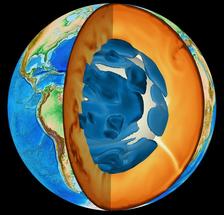3D model of the Earth with temperature variations in the cross sections: Dark is cold, sinking material at about 1000 degrees Celsius; light is hot, rising material at up to 3000 degrees. The blue surface shows where half of the iron in the ferropericlase has undergone the spin crossover - and thus where the strongest effects on physical properties are expected - illustrating the strong temperature dependence of the spin crossover. (Credit: University of Oxford, Paula Koelemeijer/GPlates)
A sophisticated high-pressure experiment has provided new insights into the Earth’s lower mantle. Using DESY’s X-ray source PETRA III, an international team of researchers has simulated the conditions in the Earth’s interior and studied the second most abundant mineral in the lower mantle, ferropericlase. The results are important for the interpretation of seismic waves – and could one day make it possible to constrain lower mantle temperatures, as the researchers led by Hauke Marquardt of the University of Oxford report in the journal Earth and Planetary Science Letters.
Ferropericlase is a magnesium-iron oxide. At high pressures, an unusual phenomenon occurs: Ferropericlase temporarily becomes softer, in other words more compressible. This has a direct effect on seismic wave velocities which are slowed down by the softening of the mineral. This behaviour of ferropericlase can be explained at the atomic level. The electrons of the iron reorganise themselves to form pairs of electrons with opposite spin – that is, they “spin” in opposite directions. This redistribution of electrons, known as the spin crossover, reduces the diameter of the iron atoms.
The team measured how the spin crossover affects the compressibility of ferropericlase, and hence the velocity of seismic waves, for the first time at high temperatures approaching those occurring in the Earth’s mantle. To do this, the scientists used a heatable high-pressure cell. “The spin crossover is highly dependent on temperature,” says lead author Viktoria Trautner from the University of Oxford. In the high-pressure cell, the team heated ferropericlase to almost 1200 degrees Celsius. The researchers then used X-rays to measure the compressibility of the sample at the Extreme Conditions Beamline P02.2 at PETRA III.
“At room temperature, the spin crossover begins at around 400,000 times atmospheric pressure,” explains lead researcher Marquardt. “At 1000 degrees, on the other hand, it doesn’t start until around 500,000 times atmospheric pressure.” Using the measurements to calibrate a new theoretical model, the team was able to extrapolate the results of their measurements to the temperatures found in the Earth’s mantle which increase with depth and reach more than 3000 degrees Celsius.
The scientists then used 3D modelling of the Earth’s interior to simulate the effect of the spin crossover on the behaviour of seismic waves and compared this with actual seismic measurements. Their initial analyses support the assumption that ferropericlase makes up about 20 per cent of the Earth’s lower mantle. “The lower mantle extends from a depth of 660 kilometres to about 2900 kilometres,” says co-author Hanns-Peter Liermann, who is in charge of the P02.2 beamline at PETRA III. “There is no way of exploring it directly. Experiments like ours are the only way to learn about mantle mineral properties.”
The behaviour of seismic waves can be used to study the structure and composition of the Earth’s mantle which strongly affect the physical properties and dynamics of the Earth’s interior. A more accurate modelling of the Earth’s lower mantle will in turn aid the interpretation of seismic waves, the researchers explain. “It may even be possible in the future to estimate the temperature at certain depths based on the behaviour of seismic waves under influence of the spin crossover," says Trautner. However, this would require more detailed seismic measurements and models than currently available.
(from DESY News)
Reference:
Compressibility of ferropericlase at high-temperature: Evidence for the iron spin crossover in seismic tomography; Viktoria E. Trautner, Stephen Stackhouse, Alice R. Turner, Paula Koelemeijer, D. Rhodri Davies, Alba San José Méndez, Niccolo Satta, Alexander Kurnosov, Hanns-Peter Liermann, Hauke Marquardt; „Earth and Planetary Science Letters“, 2023; DOI: 10.1016/j.epsl.2023.118296







